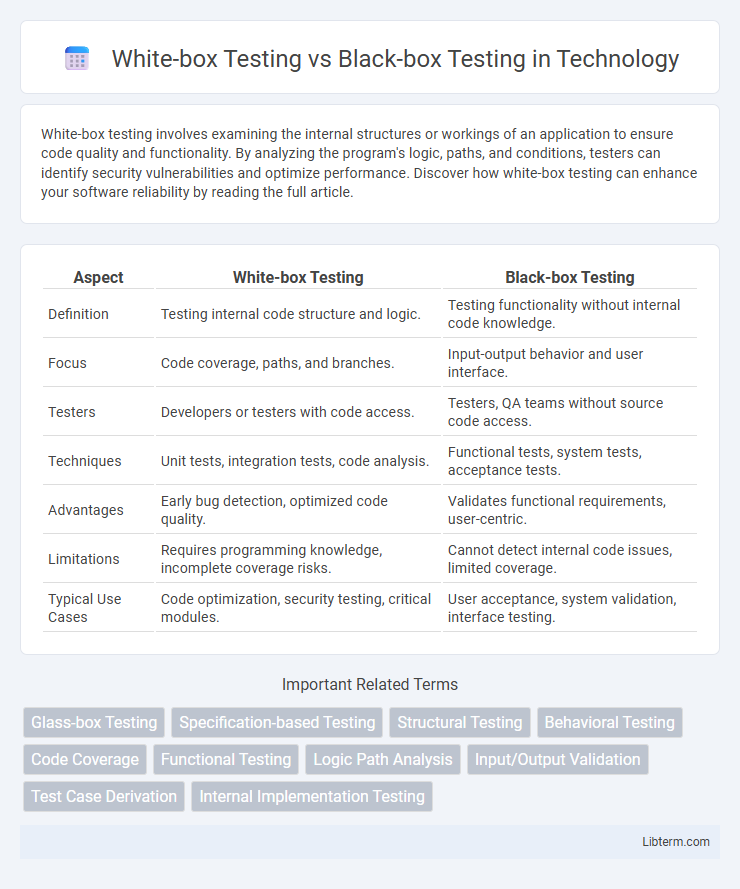White-box testing involves examining the internal structures or workings of an application to ensure code quality and functionality. By analyzing the program's logic, paths, and conditions, testers can identify security vulnerabilities and optimize performance. Discover how white-box testing can enhance your software reliability by reading the full article.
Table of Comparison
| Aspect | White-box Testing | Black-box Testing |
|---|---|---|
| Definition | Testing internal code structure and logic. | Testing functionality without internal code knowledge. |
| Focus | Code coverage, paths, and branches. | Input-output behavior and user interface. |
| Testers | Developers or testers with code access. | Testers, QA teams without source code access. |
| Techniques | Unit tests, integration tests, code analysis. | Functional tests, system tests, acceptance tests. |
| Advantages | Early bug detection, optimized code quality. | Validates functional requirements, user-centric. |
| Limitations | Requires programming knowledge, incomplete coverage risks. | Cannot detect internal code issues, limited coverage. |
| Typical Use Cases | Code optimization, security testing, critical modules. | User acceptance, system validation, interface testing. |
Introduction to Software Testing Techniques
White-box testing evaluates software by examining internal code structure, logic, and paths to ensure coverage and identify hidden errors, utilizing techniques like statement, branch, and path coverage. Black-box testing assesses software functionality without knowledge of internal code, focusing on input-output validation, usability, and compliance with requirements through methods such as equivalence partitioning, boundary value analysis, and functional testing. Both techniques are fundamental in software testing strategies to guarantee quality, reliability, and error detection from complementary perspectives.
What is White-box Testing?
White-box testing involves examining the internal structures or workings of an application, unlike black-box testing which focuses on outputs. It requires testers to have knowledge of the source code, enabling them to design test cases that cover paths, branches, and conditions within the software. This method helps identify hidden errors, security vulnerabilities, and code optimization issues by directly analyzing the program logic.
What is Black-box Testing?
Black-box testing is a software testing method where the tester evaluates the functionality of an application without any knowledge of the internal code structure or implementation details. It focuses on input-output validation by providing test inputs and analyzing the outputs to ensure the system meets specified requirements. This testing approach is widely used for functional testing, acceptance testing, and system testing to identify discrepancies between expected and actual behavior.
Key Differences Between White-box and Black-box Testing
White-box testing involves examining the internal code structure, logic, and pathways of a software application to ensure all code branches and conditions function correctly, whereas black-box testing focuses on validating functionality against specified requirements without knowledge of internal code. White-box testing requires programming skills and access to source code, enabling detailed inspection of control flow and data flow; black-box testing relies on input-output analysis and user behavior scenarios. The primary distinction lies in white-box testing's transparency into internal workings versus black-box testing's emphasis on external behavior and user experience validation.
Advantages of White-box Testing
White-box testing offers deep code coverage by examining internal structures, enabling early bug detection and optimization of complex algorithms. It provides precise test cases derived from source code, improving the accuracy of defect identification and facilitating security vulnerability assessments. This method enhances debugging efficiency and code quality by validating logical paths and individual function performance.
Advantages of Black-box Testing
Black-box testing offers the advantage of testing software functionality without requiring knowledge of the internal code structure, enabling testers to focus on user experience and output validation. This method effectively identifies discrepancies between expected and actual system behavior, ensuring that software meets functional requirements. It is particularly useful for uncovering integration issues and validating overall system performance from an end-user perspective.
Limitations of White-box Testing
White-box testing requires thorough knowledge of the internal code structure, making it time-consuming and less practical for large, complex applications. It often struggles to identify missing functionalities or validate overall system behavior, as it focuses solely on internal logic. This limitation reduces its effectiveness in finding user interface errors, performance issues, and integration problems that are better detected by black-box testing methods.
Limitations of Black-box Testing
Black-box testing faces limitations such as the inability to examine the internal code structure, leading to incomplete test coverage and potential oversight of hidden errors. It relies heavily on specifications and functional requirements, which can cause missed edge cases or logical faults not outlined in the documentation. This testing method often results in redundant test cases and requires extensive testing to identify all possible input combinations and system behaviors.
When to Use White-box vs Black-box Testing
White-box testing is ideal during the development phase when access to internal code structure and logic is necessary for thorough unit and integration testing. Black-box testing is preferred in later testing stages, such as system and acceptance testing, where the focus is on validating functionality against requirements without knowledge of the internal code. White-box testing uncovers hidden errors and optimizes code paths, while black-box testing ensures end-user requirements and overall system behavior are met.
Conclusion: Choosing the Right Testing Approach
Selecting between white-box testing and black-box testing depends on project requirements, resource availability, and testing goals. White-box testing excels in uncovering internal code vulnerabilities and optimizing software performance, while black-box testing ensures functionality meets user expectations without requiring access to source code. Combining both approaches often delivers comprehensive coverage, balancing code integrity verification with validation of external behavior.
White-box Testing Infographic

 libterm.com
libterm.com